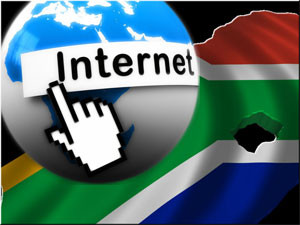
Today, more South African households connect to the Internet than the previous year, according to the latest Statistics South Africa (Stats SA) report.
The research shows 53.3% South African households have at least one member with access to the Internet either at home, work, place of study or Internet caf'es, notes the report.
Stats SA yesterday released its "General Household Survey" report, which showed an increase in the number of South Africans accessing the Internet. Last year's report recorded only 48.7% connecting to the Internet.
George Kalebaila, IDC senior research manager for telecoms and media in Africa, says: "The latest Internet penetration data from Stats SA aligns with our own understanding of the situation.
"The main driver of this trend is the growing penetration of smartphones, which stands at just over 40%, which is primary means for Internet access. If we exclude mobile, Internet penetration from fixed broadband is just about 5.3%. Therefore, this shows the importance of mobile in driving access to the Internet not only in SA but in Africa," Kalebaila explains.
Ovum senior analyst Richard Hurst notes the increase is largely due to the mobile broadband market that is being developed by network operators.
Modes of access
The Stats SA report found "the places where the largest percentages of South Africans tend to access the Internet include at work (15.1%), within the household/at home (9.7%), and at school/university/college (5.1%)".
"The fact that the majority of access is via the workplace will show the enterprise segment is playing an important role in creating awareness among consumers and giving impetus to the digital transformation of South African businesses," says Hurst.
Kalebaila agrees that most enterprises are well-served and provide better Internet connectivity, especially with WiFi becoming more prevalent in the workplace.
"This phenomenon is not restricted to SA. It is common across many regions but may just be more prevalent in Africa where workplaces offer better connectivity to the Internet and also because of the cost of data for consumers.
"Most employees prefer to access the Internet at work for more data-intensive applications, such as downloading, backups and other applications, and do less data-intensive applications, such as browsing, at home or outside the work environment. This situation is expected to change with public WiFi and data becoming more accessible and affordable," he states.
Top contenders
According to the report, households in rural areas had the least access to the Internet, while those in metro areas generally had the best access.
Gauteng and the Western Cape are the leading provinces with the highest number of users that access the Internet using all available means to them, which is not surprising, says Kalebaila.
The Stats SA report reveals "more than half of households in Gauteng (65.7%) and Western Cape (63.3%) had access to the Internet".
Gauteng, the country's economic hub, has various initiatives in place to provide and increase Internet access for citizens. Earlier this year, in the State of the Province Address, premier David Makhura said the region will reach 100% broadband connectivity by 2019.
Three of the province's metros have rolled out free public WiFi zones. The City of Tshwane has connected 700 free WiFi hotspots, while there are 408 free WiFi hotspots in Johannesburg and Ekurhuleni.
The Western Cape government is also aggressively rolling out high-speed broadband to connect its citizens.
In January, the City of Cape Town announced plans to expand its free Internet network by adding 30 more WiFi zones. There are further plans to add 60 more zones in this financial year to June 2017.
"Gauteng and Western Cape being the most affluent regions of SA, it is not surprising Internet penetration is the highest in these provinces. Also, the state of telecoms infrastructure in these two provinces is much better and widespread than any other province," Kalebaila says.
"These provinces are well-covered with 3G mobile and most of the LTE implementations so far are concentrated in these areas. The fibre to the x (FTTX) rollout that we have seen is mostly concentrated in these two provinces as well. Therefore, this situation is not expected to change anytime soon."
Hurst notes the uptake of Internet services in the rural areas should be of equal importance and relevance. "In this instance, we have several challenges, among them the availability of the infrastructure and devices, as well as the need to create end-user knowledge."
Share